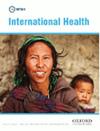第一代和第二代移民中的肉样瘤病:对瑞典所有 18 岁及以上成年人的队列研究。
IF 2.3
4区 医学
Q2 PUBLIC, ENVIRONMENTAL & OCCUPATIONAL HEALTH
引用次数: 0
摘要
背景缺乏对移民肉样瘤病的研究,这一点很有意义,因为来自某些国家的移民可能会受到遗传和环境特征的影响。我们的目的是研究第一代和第二代移民患肉样瘤病的危险比(HRs),并将其与瑞典成年总人口中的本土瑞典人进行比较。肉样瘤病的定义是:1998年1月1日至2018年12月31日期间,在全国患者登记册中至少有两次登记诊断。Cox回归分析用于估算第一代和第二代移民与本地瑞典人相比首次登记肉样瘤病的HRs及99%置信区间(CIs)。第一代研究共纳入 6 175 251 人,其中 12 617 例为肉样瘤病,第二代研究共纳入 4 585 529 人,其中 12 126 例为肉样瘤病。外国出生的男性患肉样瘤病的总风险较低(完全调整后 HR 为 0.63 [99% CI 0.57 至 0.69]),但外国出生的女性患肉样瘤病的总风险不高(完全调整后 HR 为 0.98 [99% CI 0.90 至 1.06])。第二代移民的总体风险略低(HR 0.82 [99% CI 0.78 至 0.88])。来自亚洲的女性的风险较高(HR 1.25 [99% CI 1.02 至 1.53]),而来自非洲的女性的风险呈潜在趋势(HR 1.47 [99% CI 0.99 至 2.19])。本文章由计算机程序翻译,如有差异,请以英文原文为准。
Sarcoidosis in first- and second-generation immigrants: a cohort study of all adults 18 years of age and older in Sweden.
BACKGROUND
There is a lack of studies on sarcoidosis among immigrants, which is of interest as there may be genetic and environmental characteristics affecting immigrants from certain countries. We aimed to study hazard ratios (HRs) of sarcoidosis in first- and second-generation immigrants, comparing them with native Swedes in the total adult Swedish population.
METHODS
We conducted a nationwide study of individuals ≥18 y of age. Sarcoidosis was defined as at least two registered diagnoses in the National Patient Register between 1 January 1998 and 31 December 2018. Cox regression analysis was used to estimate HRs with 99% confidence intervals (CIs) of first registration of sarcoidosis in first- and second-generation immigrants compared with native Swedes. The Cox regression models were stratified by sex and adjusted for age, comorbidities and sociodemographic characteristics.
RESULTS
In total, 6 175 251 were included in the first-generation study, with 12 617 cases of sarcoidosis, and 4 585 529 in the second-generation study, with 12 126 cases. The overall sarcoidosis risk was lower in foreign-born men (fully adjusted HR 0.63 [99% CI 0.57 to 0.69]) but not in foreign-born women (fully adjusted HR 0.98 [99% CI 0.90 to 1.06]). The overall risk was slightly lower in second-generation immigrants (HR 0.82 [99% CI 0.78 to 0.88]). Women from Asia exhibited a higher risk (HR 1.25 [99% CI 1.02 to 1.53)], while a potential trend was observed among women from Africa (HR 1.47 [99% CI 0.99 to 2.19]).
CONCLUSIONS
Sarcoidosis risk was lower in foreign-born men but not in women and also lower in second-generation immigrants.
求助全文
通过发布文献求助,成功后即可免费获取论文全文。
去求助
来源期刊

International Health
PUBLIC, ENVIRONMENTAL & OCCUPATIONAL HEALTH-
CiteScore
4.50
自引率
0.00%
发文量
83
审稿时长
>12 weeks
期刊介绍:
International Health is an official journal of the Royal Society of Tropical Medicine and Hygiene. It publishes original, peer-reviewed articles and reviews on all aspects of global health including the social and economic aspects of communicable and non-communicable diseases, health systems research, policy and implementation, and the evaluation of disease control programmes and healthcare delivery solutions.
It aims to stimulate scientific and policy debate and provide a forum for analysis and opinion sharing for individuals and organisations engaged in all areas of global health.
 求助内容:
求助内容: 应助结果提醒方式:
应助结果提醒方式:


